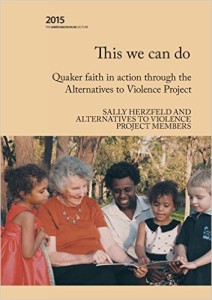This We Can Do: Quaker Faith in Action through the Alternatives to Violence Project
Reviewed by Martha Baer
April 1, 2016
 By Sally Herzfeld and Alternatives to Violence Project members. James Backhouse Lecture, 2015. 63 pages. $5/pamphlet.
By Sally Herzfeld and Alternatives to Violence Project members. James Backhouse Lecture, 2015. 63 pages. $5/pamphlet.
Buy on FJ Amazon Store
“Never doubt that a small group of thoughtful committed citizens can change the world.” This quote by Margaret Meade comes to mind when reading Sally Herzfeld’s This We Can Do. Her knowledgeable account of the Alternatives to Violence Project (AVP) details a history that is not otherwise readily available. In her descriptions she captures a fascinating glimpse of how vision and persistence combined with faith and action can change the world one person at a time.
In the case of AVP, it began with grassroots efforts to address youth violence by a small group of inmates at the Green Haven Maximum Security Prison in New York in 1975. Through a network of connections, they tapped into knowledge from the nonviolent movement during the turbulent struggle for civil rights in the ’60s, and found partners among Friends who were volunteering in the prisons.
Who knows when local grassroots movements might burgeon into international initiatives? At the beginning of such a trajectory, we have no idea the scope of what might evolve. Hindsight is the only surefire way to recognize the importance. In this pamphlet, Herzfeld provides us with this perspective on those early beginnings in the Green Haven Prison.
As Herzfeld chronicles AVP’s evolution over the years, she describes the influence of Quaker philosophy on the principles and activities that make up AVP workshops, and how AVP has evolved in multiple settings: prisons, schools, youth work, trauma healing, community reparation, police training academies, and Friends Peace Team initiatives. With a narrative style, she shares her personal experiences and learning from the international AVP conferences. She references, by name, the individuals involved in AVP efforts, taking care to highlight those who are Friends. It becomes clear that the drive and success behind AVP has grown out of individual commitment. “Apart from money, to start a group, at least one passionate and dedicated person is needed to drive it,” notes Herzfeld. The pioneers are named and their affiliations carefully charted.
For those who have not yet experienced AVP and are curious, the chapter “What is an AVP workshop?” offers a glimpse into the experiential and reflective nature of these workshops. By describing some of the activities, including participant responses, and giving a sense of the format for a workshop, Herzfeld does an excellent job of answering the framing question of the chapter title.
This pamphlet is based on a lecture given in 2015 as part of the James Backhouse Lecture series, a series initiated by Australia Yearly Meeting in 1964 to “bring fresh insights into the Truth, and speak to the needs and aspirations of Australian Quakerism.” Asked to share her knowledge of and experience with the Alternatives to Violence Project, it is not surprising that Herzfeld focuses a chapter on how AVP has been evolving within Australia. In light of the 2016 AVP International Conference to be held in Sydney, this provides interesting context for those who may be planning to attend.
As an AVP facilitator myself, This We Can Do added details to my knowledge and understanding of the roots of AVP. I found it fascinating to have a greater context for how the nonviolent trainings from the ’60s were incorporated into AVP. This gives me a great appreciation for the historical basis for elements such as role play. At the same time, it reminds me of the work that remains to be done. As we engage in efforts to reform our criminal justice system, serve youth with untapped potential, and continue our own efforts to learn how to resolve conflict across difference, it is encouraging to be reminded how seemingly small, individual efforts can have immense impact.
As the Alternative to Violence Project celebrates its fortieth anniversary and some of the original founders age or pass away, the opportunity to have the oral history recorded in This We Can Do is an opportunity not to be lost.



Comments on Friendsjournal.org may be used in the Forum of the print magazine and may be edited for length and clarity.